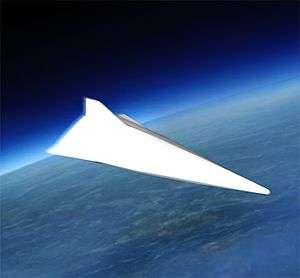DF-ZF
| WU-14/DF-ZF | |
|---|---|
 | |
| One of the configurations of Chinese HGVs | |
| Role | Experimental aircraft |
| National origin | People's Republic of China |
| First flight | 9 January 2014 |
The DF-ZF[1] is a Chinese experimental hypersonic glide vehicle (HGV), previously known by the Pentagon as WU-14.[2][3]
Testing
The DF-ZF or DH-17 (previously designated as the WU-14) is a hypersonic missile delivery vehicle that has been flight-tested by China seven times, on 9 January, 7 August and 2 December 2014; 7 June and 27 November 2015;[1] in April 2016[4] and twice in November 2017. The system is expected to be operational by 2020.[5]
The Chinese Defense Ministry confirmed its January 2014 test and said the test was "scientific" in nature, although it was widely viewed as part of a broader Chinese military build-up.[6] All seven tests China performed so far were concluded successfully according to US officials cited in the Washington Free Beacon.[7][8] All the test launches were performed at the Taiyuan Satellite Launch Center in Shanxi Province, the main long-range missile testing center for the People's Liberation Army.[1][4]
Capabilities and design
The DZ-ZF is thought to reach speeds between Mach 5 (3,836 mph (6,173 km/h)) and Mach 10 (7,680 mph (12,360 km/h)).[4] The glider could be used for nuclear weapons delivery but could also be used to perform precision-strike conventional missions (for example, next-generation anti-ship ballistic missiles), which could penetrate "the layered air defenses of a U.S. carrier strike group."[1][4]
Hypersonic glider vehicles are less susceptible to anti-ballistic missile countermeasures than conventional reentry vehicles (RVs).[4] Normal RVs descend through the atmosphere on a predictable ballistic trajectory—a hypersonic glider like the HGV can pull-up after reentering the atmosphere and approach its target in a relatively flat glide, lessening the time it can be detected, fired at, or reengaged if an initial attack fails. Gliding makes it more maneuverable and extends its range.[9] Although gliding creates more drag, it flies further than it would on a higher trajectory through space, and is too low to be intercepted by exo-atmospheric kill vehicles. The tradeoff is that warheads have less speed and altitude as they near the target, making them vulnerable to lower-tier interceptors,[10] such as the Mach 17 Russian 53T6, ABM-3 Gazelle. Other potential counter-hypersonic interception measures may involve laser or rail gun technologies,[11] but such technologies will not be readily available.[12][13][14]
According to one source,[4] a weakness in the Chinese DF-ZF program is a lack of high-performance computing power, which stymies design work. However, 2 of China's supercomputers have been named the world's top 2 fastest systems in 2016's and 2017's TOP500 list. [15][16] As of November 2017, China also tops the list in number of declared supercomputers (202 systems) and aggregate computing power (35.4% of the full list.)[16]
A vehicle like the DF-ZF could be fitted to various Chinese ballistic missiles, such as the DF-21 medium-range missile (extending range from 2,000 to 3,000 km (1,200 to 1,900 mi)), and the DF-31 intercontinental ballistic missiles (extending range from 8,000 to 12,000 km (5,000 to 7,500 mi)[17]. Analysts suspect that the DZ-ZF will first be used in shorter-range roles as an anti-ship missile and for other tactical purposes to address the problem of hitting a moving target with a ballistic missile. Long-term goals may include deterrence of U.S. missile capabilities with the prospect of strategic bombardment against the USA, or other countries.
Since conventional interceptor missiles have difficulty against maneuvering targets traveling faster than Mach 5 (the DZ-ZF reenters the atmosphere at Mach 10), a problem exacerbated by decreased detection times, the U.S. may place more importance on developing directed-energy weapons as a countermeasure.[9] However, after decades of R&D, directed-energy weapons are still very much at the experimental stage and it remains to be seen if or when they will be deployed as practical, high-performance military weapons.[12][13][14]
See also
- Avangard – a Russian hypersonic warhead
- Hypersonic Technology Vehicle 2 and Advanced Hypersonic Weapon – a similar US test vehicle and warhead
- HYFLEX - a Japanese Hypersonic Flight Experiment
- Hypersonic Technology Demonstrator Vehicle - an Indian hypersonic vehicle under development
- DARPA Falcon Project - Prompt Global Strike
- Rockwell X-30, 1990-1993 project for SSTO prototype
- Boeing X-51
- Second Artillery Corps
References
- 1 2 3 4 Richard D Fisher Jr, US officials confirm sixth Chinese hypersonic manoeuvring strike vehicle test, IHS Jane's Defence Weekly (November 27, 2015).
- ↑ http://www.popsci.com/blog-network/eastern-arsenal/hypersonic-gliders-scramjets-and-even-faster-things-coming-chinas
- ↑ http://www.spacedaily.com/reports/Chinas_Hypersonic_Glide_Vehicle_A_Threat_to_the_United_States_999.html
- 1 2 3 4 5 6 Franz-Stefan Gady, China Tests New Weapon Capable of Breaching US Missile Defense Systems, The Diplomat (April 28, 2016).
- ↑ http://www.spacedaily.com/reports/China_tests_new_ballistic_missiles_with_hypersonic_glide_vehicles_999.html
- ↑ "China confirms hypersonic missile carrier test". Reuters. January 16, 2014.
- ↑ "Stratcom: China Moving Rapidly to Deploy New Hypersonic Glider". the Washington Free Beacon. 2016-01-22.
- ↑ "China Successfully Tests Hypersonic Missile". the Washington Free Beacon. 2016-04-27.
- 1 2 U.S. Navy Sees Chinese HGV as Part of Wider Threat, Aviation Week, 27 January 2014
- ↑ Introducing the Ballistic Missile Defense Ship - Aviation Week 11 April 2014
- ↑ U.S., China in Race to Develop Hypersonic Weapons - Nationaldefensemagazine.org, 27 August 2014
- 1 2 https://thebulletin.org/navys-new-laser-weapon-hype-or-reality8326
- 1 2 https://www.forbes.com/sites/lorenthompson/2011/12/19/how-to-waste-100-billion-weapons-that-didnt-work-out/
- 1 2 https://spectrum.ieee.org/tech-talk/aerospace/military/no-quick-laser-missile-defense
- ↑ "New Chinese Supercomputer Named World's Fastest System on Latest TOP500 List". TOP500 News Team. 2016-06-20.
- 1 2 "TOP500's November 2017 List". TOP500 News Team. 2017-11-12.
- ↑ Biswas, Arka (2015). "China's WU-14 Nuclear Device: Impact on Deterrence Equation". IndraStra Global (6): 5.